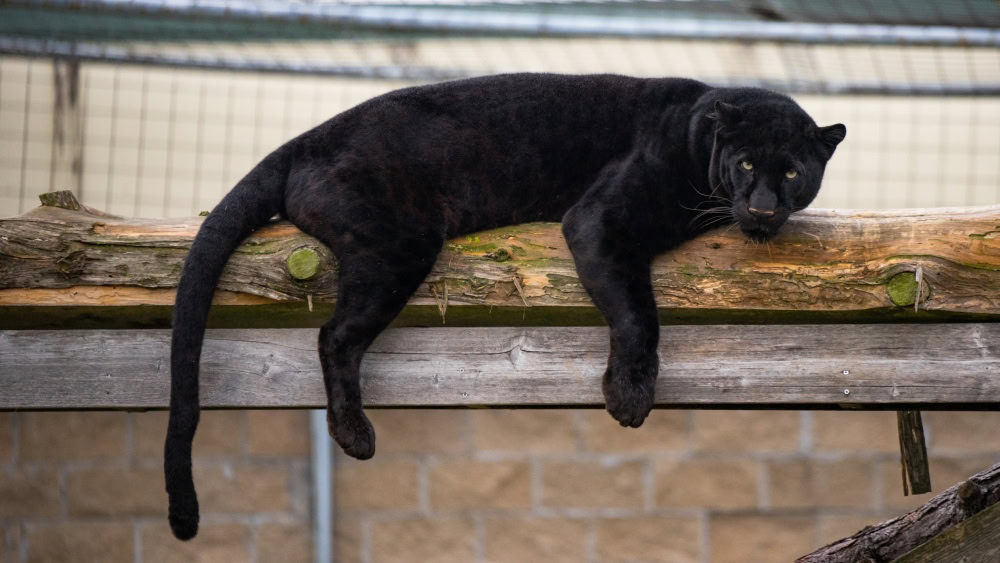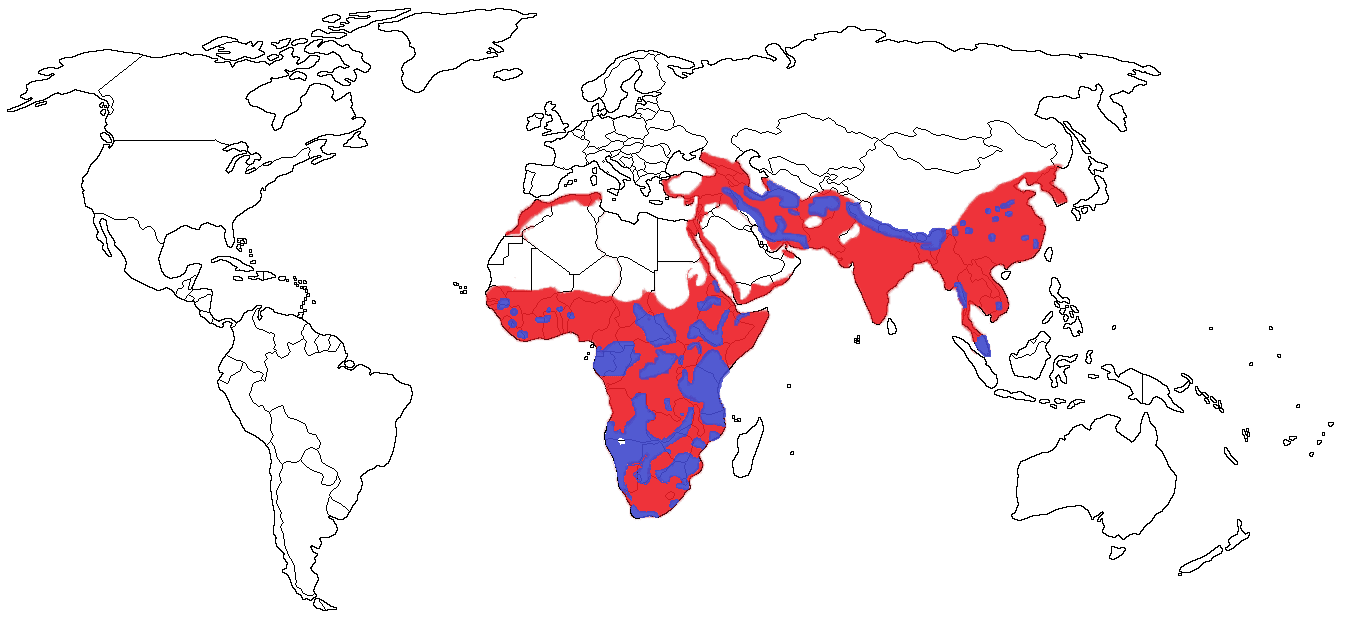
Taxonomy
Kingdom: Animalia
Phylum: Chordata
Class: Mammalia
Order: Carnivora
Family: Felidae
Genus: Panthera
Species: pardus
Scientific Name: Panthera pardus
IUCN Red List Status: Vulnerable
About
Habitat: The leopard is the most widespread felid, extending across much of Africa and Asia, from the Middle East to the Pacific Ocean. Because of their range, the habitat type varies. They can be found in areas ranging from tropical rainforests and deserts to alpine mountains and even the outskirts of cities. Out of the five big cats, the leopard is the only one known to live in both deserts and rainforest environments.

Territoriality: Leopards are solitary animals, who will only be seen in groups if the female is raising cubs. When hunting or just patrolling their territory, leopards will scent mark as they go. Adult males will announce their area by producing a hard, grunting, barking call to alert other leopards to not trespass. This call is often compared to a handsaw cutting wood. Females will typically call when they are in estrus and are ready to mate. They will also call their cubs. The home ranges of leopards vary with prey availability and habitat structure. The most extensive recorded home range for a leopard was 842 square miles, while the smallest was 3.5.
Lifespan
In the Wild: 10-12 years
In Captivity: 21-23 years
Population
Unknown
Physical Description
Weight: 60-150 pounds
Length: 7.75- 10.75 ft (head to tail)
Leopards are light-colored cats with distinctive dark spots covering their fur. These spots, called rosettes, allow the animals to camouflage their bodies as they move through the grass and hide in trees. Sometimes black leopards do have the potential to occur, but this does not make them a different species. These leopards have extra melanin making them appear darker. If you look closely, they still have their rosettes! The color of their coat does depend on the location of the cat. Leopards living in the savanna will have orange or yellow fur, while one living in the desert is paler. If they live in colder environments, the coat tends to be longer and grayer, but if they are in the rainforest, it is more golden in coloration.
Reproduction
Gestation Period: 88 to 112 days
Litter Size: 1 to 6 cubs (2 to 3 average)
Female leopards can reach sexual maturity between the ages of two and four years of age. Males can start breeding as young as one and a half years old. While leopards can mate year-round, most litters are born in the wet season, particularly in December. Females will attract a male through scent marking and vocalizations. Once they have mated, they may remain together for up to five days to ensure that the female will become pregnant. The babies are born with short fur, closed eyes, toothless, and pink skin on their noses and paws. Mothers will protect their cubs by hiding them in dense brush, hollow tree trunks, or rocks while she is hunting. They will frequently move their den site to prevent other predators from finding them. The female will begin weaning her babies around four months. They will then start eating meat and assisting with the hunting to learn how to be a successful adult. When the leopards reach independence at 13 months old, males will disperse, and females frequently take over part of their mother’s range.
Diet and Hunting Behaviors
Leopards are obligate carnivores, meaning they eat only meat. Their diet is heavily dependent upon the availability of prey and is, therefore, one of the most varied of big cat species. They prefer medium-sized ungulates but will feed on insects, birds, reptiles, and small mammals if needed. When females have cubs, they will kill smaller prey. Some individuals will become specialists for a particular prey item, only feeding on that prey exclusively. They require between 3.5- 11 pounds of meat per day to maintain their body mass. Leopards will kill around 40 prey items per year to achieve the food intake. If there are competing carnivores in an area, leopards are known to stash their kill under thick vegetation or raise the kill into the limbs of a tree. Leopards may even drag its kill several hundred meters to trees or bushes.
When leopards hunt, they require dense cover to be successful as they are ambush predators, who will not typically chase their prey after they pounce. Group hunting is not beneficial as a leopard must capture its prey before it can flee. The number one way to attack is to stalk within a short distance and then pounce going after their prey’s neck.
Fun Facts
- Leopards are the largest cats to climb trees regularly.
- They can carry 3 to 5 times their weight into the trees.
- About 11% of leopards alive today are said to be melanistic or black.
Threats and Conservation
Leopards exist in 64 countries across the world, in a wide variety of ecosystems and habitats. Because of this, leopards are facing multiple threats, including habitat loss and fragmentation, conflict due to livestock predation; loss of prey populations; persecution for the illegal trade; and unsustainable legal trophy hunting. With all of these threats impacting leopards, the conservation actions that are implemented to help them can vary depending on the area. Actions can range from strict hunting regulations to protecting wildlife areas for leopard refuge.
The land across much of the leopard’s range has been converted to agriculture to produce crops for the growing human population. By converting the land, it greatly reduces the quality of the habitat, creating fragments, lowering the number of leopards who can live in a single area. They are thought only to be extant or currently exist, in 25% of their historic range. Many countries are reserving land as National Parks or protected areas, to remediate this habitat fragmentation and destruction. In 2001, Amur leopard numbers were decreased to 30 individuals. To prevent their complete extinction, the World Wildlife Fund, along with the Russian government, headed efforts to create a conservation area specifically to protect these big cats. The Land of the Leopard National Park was officially established in 2012 but attempts to protect the species have been in the works for almost 20 years. In the time between 2007 and 2015, amur leopard populations have increased by 90 percent. This is evidence that the formation of protected areas is one of the most beneficial species preservation tactics.
As apex predators, leopards are often feared for their potential attacks on people and livestock. However, they tend to avoid livestock unless they lack other options for prey. Even though this is rare, for some communities who rely on their livestock for their income, it can be detrimental. Attacks on livestock are more likely to occur when their native prey is scarce. As the population of their prey is lowering, leopards have to find another source of food. Throughout the leopard’s range, prey populations are becoming more unstable due to habitat loss and wild meat harvests by humans. Leopards are listed in CITES Appendix I, and trade is restricted to 11 countries and 2,560 individuals in sub-Saharan Africa. But regulating trophy hunting alone will not affect the vast percentage of leopards being killed. The greater impact on reduced leopards numbers is lowering the amount of human-leopard conflict of small villages. Local farmers located in sub-Saharan Africa are allowed to kill leopards that are a danger to their livestock. Because of this, it is believed that the vast majority of leopards killed due to human-wildlife conflict are not reported. Livestock husbandry, compensation programs, and increased public awareness are being raised in areas where people live near leopards, to prevent the immeasurable killings.
The cultural and economic value of leopards has created a mass-market for their parts. Their skins and canine teeth are among their most sought after portions. To this day, those specimens are traded openly in villages and tourist shops across the world. In the decade of 2000 to 2010, there were approximately 2,295 leopards killed in India alone. This conservatively averages out to be four leopards poached every week in those ten years. But, of all of those leopards that were killed, only about half of them were reported seizures, meaning that the other half remain in illegal markets across the world being bought and sold. Religious ceremonies and communities also play a massive role in the killing of leopards for their parts, in particular their skins. It is estimated that the Shembe Church in South Africa has between 17,240 and 18,760 leopard pelts at one time to be worn for ceremonial purposes. Due to wear, these pelts are also typically traded out for new ones on an average of every three years, leading to an abundant amount of leopards being killed just for their skins. The illegal trade in these parts continues, to this day, to be a significant threat across their entire range. To try and lower the use of leopard skins for ceremonies, conservationists have partnered with textile companies to provide faux fur alternatives.